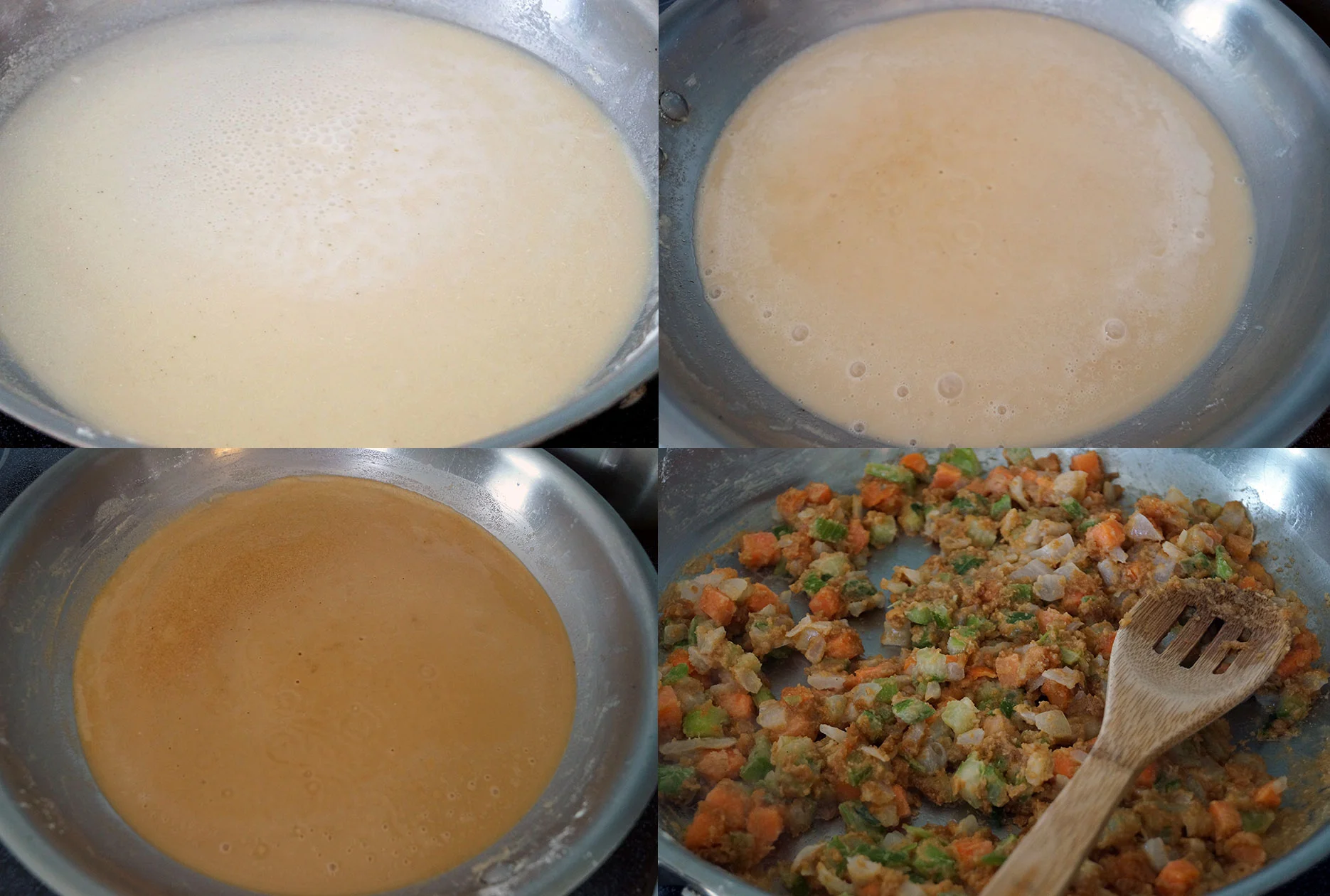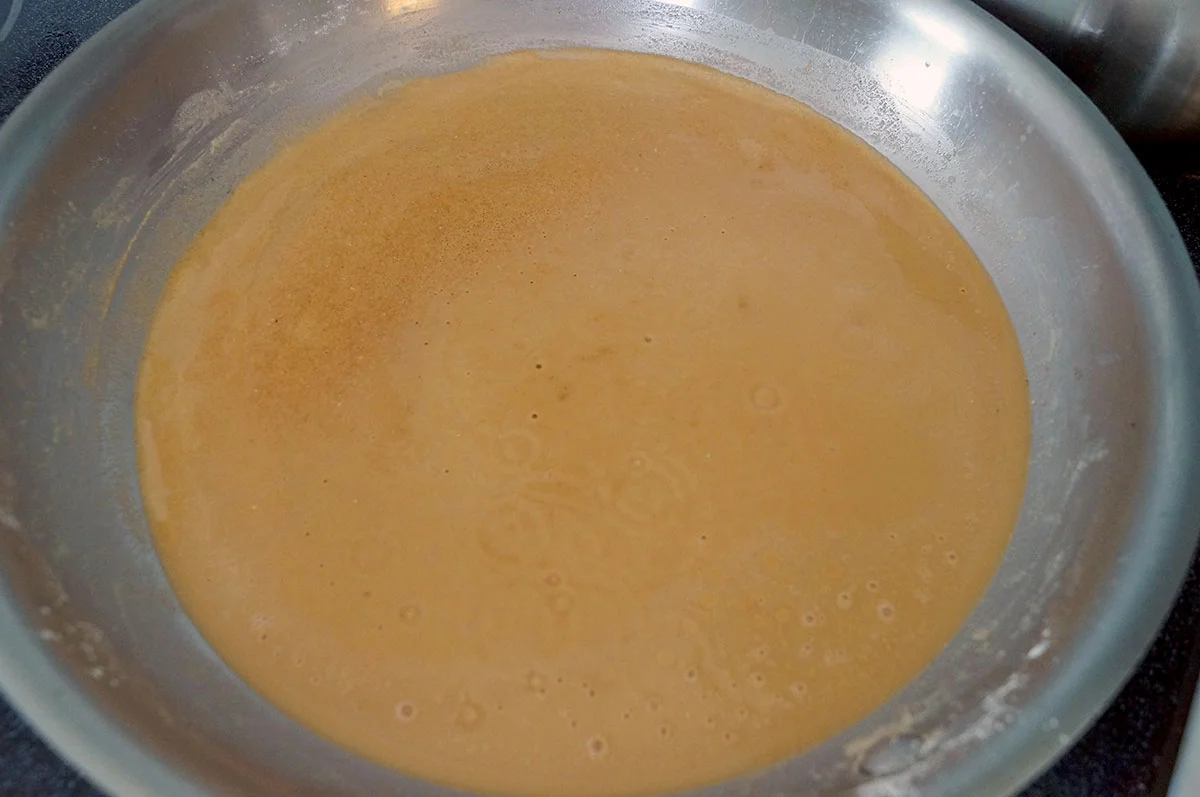A good roux-based gravy is at the heart of countless classic dishes like shrimp Creole, gumbo, pot pies, even soups, stews, and chowders. And of course, you cannot have a thick and flavorful gravy without an excellent roux base to start with (forget just stirring in tapioca starch to thicken).
Basically, any time you want to produce a rich, thick, flavorful sauce, you can incorporate a roux into your recipe, even if it isn't called for.
What is a roux?
A roux is simply a flour toasted and fried in a fat used to thicken and add a specific nutty flavor to dishes like soups, stews, and gravies.
The ratio of fat to flour varies depending on the type of flour you are using, but with these gluten-free flours (plantain and cassava flour) I find that a ratio of 1 part fat to 1.5 parts flour works well. If you want a thicker roux use more flour.
What is the best flour for a gluten-free, Paleo, or AIP roux?
The two best gluten-free, grain-free flours for making a roux are cassava flour (or here on Amazon) and plantain flour (or here on Amazon).
Cassava flour is the whole root of the yuca/cassava/manioc plant dried and ground into a flour. It is not the same thing as tapioca starch, which is the extracted starch from the same plant.
Plantain flour is the whole dried and ground green plantain and is good for making a light roux, but in my experience is not good for a dark roux.
How is a roux used?
In many classic recipes (especially Creole recipes), the roux is used to sautee the aromatics to release their flavor - either a mirepoix (which is a blend of 2 parts onion, 1 part celery, 1 part carrot) or the Cajun "trinity", which is a blend of onion, celery, and bell pepper (the amounts of each can vary depending on who you ask and which recipe you're making).
You can use a roux in ANY soup or stew to thicken it and add flavor. If you find yourself getting tired of watery, thin soups try starting the recipe off with a roux.
Many soup/stew recipes will have you begin by sauteeing vegetables in fat. Just make a nice light roux first and THEN add the veggies - your taste buds will thank you!
Also, any recipe that calls for making a slurry of tapioca or arrowroot starch and adding it to a dish to thicken it at the end can be converted to use a roux instead.
If you've got an old stand by recipe that uses a gluten-full roux that you'd like to convert to be gluten-free, Paleo, or AIP, use this roux instead!
How to make a Paleo and AIP roux
Cassava or plantain flour are your best bets for making a Paleo and even autoimmune protocol (AIP) compliant roux.
You can use any of the following fats: lard or bacon grease, tallow, ghee (if tolerated), butter (if tolerated and not following AIP), coconut oil (although this may produce an unwanted coconut flavor), sustainably sourced red palm oil, schmaltz, and even duck fat.
My favorites are lard and butter.
Light "peanut" and Dark "chocolate" roux
The longer you cook a roux, the darker it gets and the flavor will become much more intense.
Light rouxs are excellent for thickening, whereas dark rouxs don't have much thickening power but add some deep, nutty, caramel flavor.
Cassava flour will work for either type of roux, but I only recommend using plantain flour for a light roux. I have found the flavor to get unpleasantly bitter in a dark roux.
Making a cassava flour roux is very similar to a traditional white flour roux and the color changes it goes through are basically the same. Plantain flour starts out brown-ish and not white, and thus it is tricky to judge by color when the light roux is done.
You can whip up a light roux in just 15 minutes, but a dark roux takes much longer - 30 or 45 minutes. Generally speaking, any dish, sauce, or gravy that needs the thickening power of roux will do best with a quick light roux.
Dark roux is reserved to impart specific flavor and color to dishes like gumbo and etouffee.
Light "peanut" roux - cassava flour
Dark roux (40 mins cooking) - cassava flour
Tips for making gluten-free roux
You must pay close attention to the cooking process to ensure you don't burn the flour. This is not a recipe to wander off and do something else. Stay close by and keep an eye on it, pay attention to how it smells, and stir often.
Take care not to scorch the flour by cooking it at too high of a heat and/or neglecting to stir. Once it stops bubbling, it will reach light roux stage very quickly and if you are going to take it to a dark roux you need to lower the temp to med low or low to prevent burning.
You can use a gluten-free roux in my Paleo Shrimp Creole or Instant Pot Chicken Creole.
How to Make a Gluten-Free, Paleo, AIP Roux
Published 01/12/2017
A good roux is at the base of many delicious dishes, soups, stews, and gravies. Learn the easy way to make a tasty, flavorful roux with gluten-free, Paleo, and AIP flour!
Ingredients
Note: you can scale this recipe as needed, using the same ratio of 1 part fat to 1.5 parts flour.- 1/4 cup fat of choice (butter or lard recommended)
- 1/4 cup + 2 tbsp cassava flour or plantain flour
Instructions
- Melt fat of choice in a large frying pan or Dutch oven over medium heat.
- Stir in the cassava flour or plantain flour and whisk to break up any clumps.
- Continue to cook, whisking often, until you achieve a light "peanut" colored roux, which will take about 5-7 minutes. As it cooks it will bubble as the moisture cooks out. Once it stops bubbling watch it VERY closely. It will start to smell like cooked popcorn and develop a light to medium brown color. You can scorch the flour by continuing to cook at medium heat after the moisture has cooked out, so watch carefully and/or lower the heat after about 4-5 minutes while you wait for it to reach the right color. Light roux is ideal for thickening gravies, sauces, soups, stews, and more.
- If you are working on a dish like gumbo or etouffe and need a dark roux, I do not recommend using plantain flour. After achieving a light roux, lower the heat to medium low or low and continue to cook, stirring often, until the roux is a very dark brown color (like chocolate), about 30-45 minutes. It should be thick and almost paste-like and have a nutty, caramel aroma and taste.
- When using a roux to thicken a dish you would like to convert to gluten-free, Paleo, or AIP, you can add vegetables and aromatics directly to the pan with the roux to soften them as they cook in the roux, about 5-7 minutes. Deglaze the pan with your liquid (broth, wine, water, etc.) and continue your recipe.
- You can easily make a pan-gravy from any roasted meat or poultry with a roux as the base. If you have fat from the pan drippings you can skim it off and use it to make the roux. Deglaze the pan and use that liquid to make the gravy, whisking it together with the roux. If you don't have enough fat from your roast to make the roux, just use your favorite fat, deglaze the pan, and add the liquid to the roux to make a lovely gravy.
Cook time: 00 hrs. 10 mins to 00 hrs. 45 mins.
Total time: 10 mins.
Tags: paleo, AIP, gluten-free, egg-free, autoimmune protocol, cajun, creole, new orleans, rouxRecommended Ingredients for Gluten-Free Roux
These are affiliate links to the very products I trust and use in my own kitchen. I appreciate your support to keep the free content going on this site!















